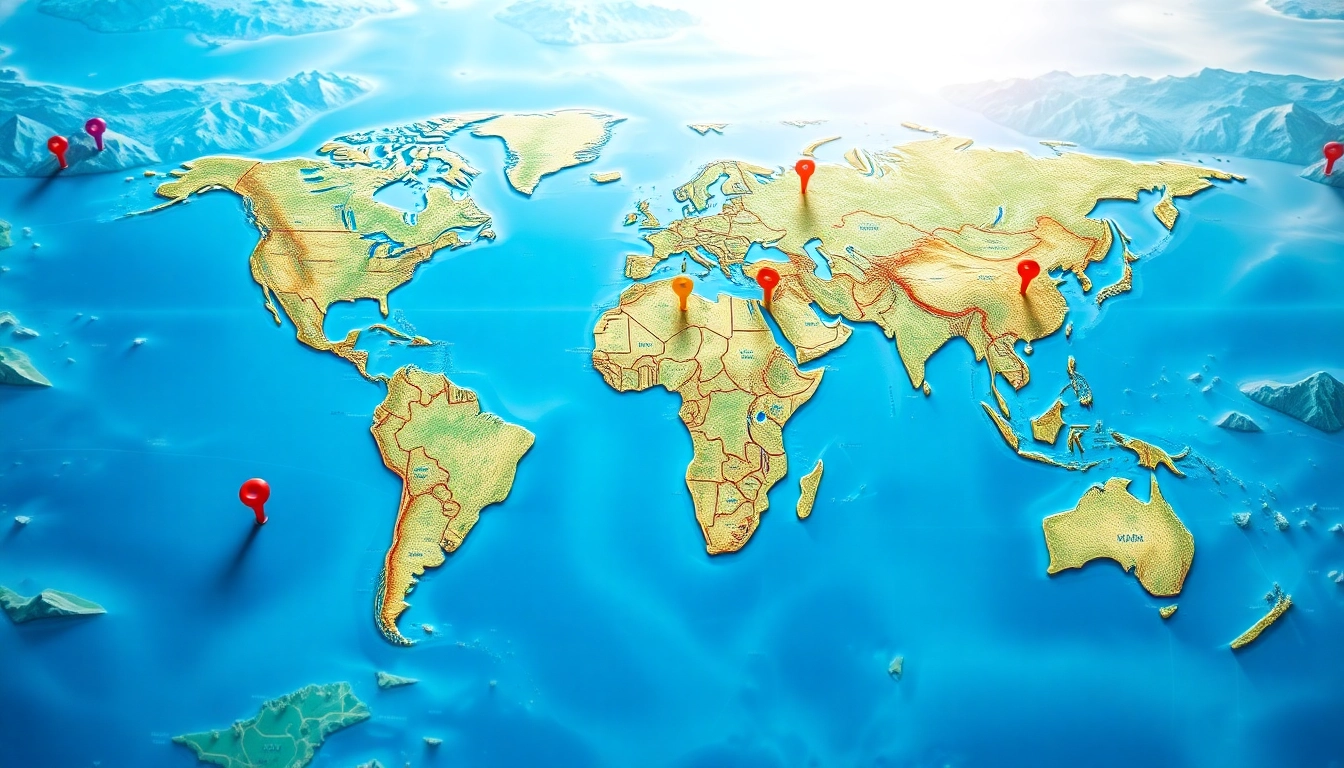Understanding Locations: A Comprehensive Overview
In our increasingly mobile and interconnected world, the concept of Locations extends beyond mere physical addresses. Knowing where we and others are positioned at any given time is crucial in navigating our daily lives, whether for personal, business, or social purposes. This article delves deep into the multifaceted nature of locations, exploring their definitions, importance, and the various contexts in which they manifest.
What are Locations?
A location can be described as a specific point in space, often represented by coordinates, addresses, or landmarks. In a geometric sense, a location refers to a position defined within a set coordinate system, such as latitude and longitude. However, in everyday life, the term is contextualized to reflect more abstract settings, including the idea of location in virtual spaces like a website URL or a digital file. Understanding these different interpretations is key to realizing their importance in both the physical and digital realms.
The Importance of Knowing Your Locations
Being aware of various locations is foundational to effective navigation and decision-making. For individuals, knowing local establishments – be it grocery stores, hospitals, schools, or landmarks – enhances convenience and ensures safety. Businesses must understand customer locations to tailor their services and marketing strategies effectively. Beyond individual or business-centric motivations, locations play a vital role in broader geographical and sociocultural contexts, impacting urban planning, resource management, and social dynamics across communities.
Different Types of Locations in Various Contexts
The concept of location transcends simple geography and can be analyzed through various lenses:
- Geographical Locations: Referring to specific places on Earth, such as cities, countries, and natural formations.
- Business Locations: Highlighting strategic sites for commercial operations, including physical stores, warehouses, and service centers.
- Virtual Locations: In digital contexts, locations might pertain to the presence within a website, a region in a virtual game, or a digital asset stored in cyberspace.
- Social Locations: These define where social interactions and community engagements occur, influenced by culture and societal structures.
How to Effectively Use Locations in Navigation
Navigation has evolved dramatically with technology; thus, understanding effective practices in using locations is critical for efficient travel and logistics.
Basic Navigation Techniques with Locations
Mastering basic navigation techniques is essential for anyone seeking to traverse physical or digital landscapes. Techniques such as reading maps, using directional signage, and familiarizing oneself with cardinal points enhance one’s ability to identify and reach specific locations. For those in unfamiliar territories, a combination of asking locals for instructions and utilizing printed or digital maps can play a vital role in effective navigation.
Using Technology to Find Accurate Locations
The advent of GPS and mobile technologies has drastically transformed how we find and utilize locations. GPS systems offer precise positioning and can guide users anywhere from rural areas to bustling urban centers. Mobile applications, such as mapping services, leverage real-time data to provide accurate directions and insights while factoring in elements like traffic patterns and road closures. Additionally, these apps often incorporate augmented reality features, offering immersive navigation experiences. With technology, users can not only identify their current location but also explore potential sites of interest based on personalized preferences.
Common Challenges in Navigating Locations
Despite technological advancements, navigating locations can present several challenges. These include:
- Inaccurate Mapping Data: Maps might not always reflect the most current developments, leading to confusion.
- Communication Barriers: Language differences in foreign countries can hinder effective navigation.
- Overreliance on Technology: While technology is helpful, it may lead to a lack of traditional navigation skills.
To address these challenges, combining technology with traditional navigation skills can lead to successful outcomes. Practicing map-reading skills, seeking local advice, and staying grounded in situational awareness can significantly enhance one’s ability to traverse locations with confidence.
Popular Tools for Identifying Locations
With various tools available to identify locations, understanding their features and functionalities can empower users in their search.
Mapping Applications and Their Features
Modern mapping applications have revolutionized how people find and interact with locations. Popular tools offer features such as:
- Real-time Traffic Updates: Allows users to avoid congested areas while navigating.
- Points of Interest: Locates restaurants, hotels, and attractions to enhance user experiences.
- Route Planning: Provides alternative routes and estimated travel times, aiding in efficient navigation.
These features ensure users are equipped with up-to-date information, resulting in reduced travel time and a greater understanding of their surroundings.
GPS Devices: How They Determine Locations
GPS devices utilize satellites to triangulate a user’s position on Earth by calculating the time it takes for signals to travel. This precision technology is critical for various applications, from transportation to outdoor activities. As GPS systems improve, so do the opportunities for urban planning, emergency response, and recreational adventures. These devices often come equipped with additional features such as tracking, mapping, and geofencing, enhancing their utility in different contexts.
Local Search Services: Finding Business Locations
Local search services have become crucial for businesses aiming to attract nearby customers. Services like local listings, reviews, and maps help consumers discover company locations quickly. Implementing Search Engine Optimization (SEO) practices is essential for businesses to enhance their visibility in local searches. By creating relevant content, utilizing accurate location data, and encouraging customer feedback, businesses can optimize their digital presence and facilitate convenient access to their locations.
Best Practices for Managing Multiple Locations
For businesses that operate in various places, effective management of multiple locations is crucial for operational success and customer satisfaction.
Organizing and Categorizing Locations
Maintaining organization across locations involves categorizing sites based on criteria such as service type, demographic focus, and geographical area. Geographic Information Systems (GIS) can be instrumental in mapping and analyzing business distribution, enabling management to visualize trends and make data-driven decisions regarding resources, marketing strategies, and staffing needs.
Data Tracking for Businesses with Multiple Locations
Storing and analyzing data across locations can enhance decision-making processes. Businesses should implement centralized management systems to track important metrics such as foot traffic, sales performance, and customer feedback across their locations. Utilizing analytics tools can provide insights that inform operational consistency and help identify elevating trends or issues across multiple sites.
Optimizing User Experience Related to Locations
Delivering a seamless experience across locations requires a focus on quality service, consistency, and effective communication. Investing in employee training ensures that staff understands the company’s expectations and service protocols regardless of location. Furthermore, creating an interconnected online experience through local SEO efforts and updated information can significantly enhance user interaction, fostering brand loyalty and customer satisfaction.
The Future of Locations: Trends and Innovations
The concept of locations is continuously evolving, driven by technological advancements and changing consumer behaviors.
Emerging Technologies Shaping How We Understand Locations
Technologies such as Artificial Intelligence (AI), machine learning, and the Internet of Things (IoT) are significantly influencing how we engage with locations. AI algorithms can analyze user data to recommend nearby attractions or services, while IoT devices can provide instant feedback on traffic levels and transport options based on location. These advancements not only enhance navigation but also improve the customizing of services according to user preferences.
Geolocation Services and Their Applications
Geolocation services are increasingly integrated into various sectors, enhancing personalization and user experiences. From targeted advertising based on user location to dynamic content delivery, these services allow businesses to reach customers effectively. Ensuring privacy and ethical data use remains crucial as these technologies continue to evolve.
The Impact of COVID-19 on Location Awareness
The COVID-19 pandemic has transformed how individuals perceive locations, particularly concerning health and safety. Social distancing measures, changing travel norms, and heightened awareness of nearby healthcare facilities have all increased the importance of local knowledge. Businesses must adopt flexible strategies that prioritize health guidelines while ensuring their locations remain accessible and relevant to consumers’ needs.
In conclusion, understanding locations is crucial in our rapidly evolving world. The interplay between technology and geography shapes our experiences, informing how we navigate physical and virtual spaces. Whether through advanced mapping applications, GPS devices, or geolocation services, enhancing our awareness of Locations plays an integral role in improving connectivity, efficiency, and overall quality of life.



